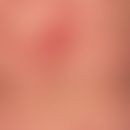Synonym(s)
DefinitionThis section has been translated automatically.
Direct acting anticoagulants.
Pharmacodynamics (Effect)This section has been translated automatically.
You might also be interested in
IndicationThis section has been translated automatically.
Limited indicationThis section has been translated automatically.
Dosage and method of useThis section has been translated automatically.
- Thrombosis prophylaxis: see table 1.
- Thrombosis and embolism: Weight-adapted full heparinisation with low-molecular-weight heparin e.g. Nadroparin (Fraxiparin) 2 times/day 0.1 ml/10 kg KG s.c.
- Only in exceptional cases unfractionated heparin 5,000 IU i.v. in bolus. over 5 min: 25,000 IU in 50 ml NaCl 0.9% over perfusor 2.8 ml/hour (= 1,400 IU/hour), control of the PTT after 6 hours and dose adjustment according to the PTT quotient:
- PTT: > 7: interruption of the infusion for one hour, dose reduction by 500 IU/hr
- PTT: 5.1-7: reduction by 500 IU/hr
- PTT: 4.1-5: Reduction by 300 IU/hr
- PTT: 3.1-4: reduction by 100 IU/hr
- PTT: 2.6-3: Reduction of 50 IU/hr.
- PTT: 1.5-2.5: No dose change required
- PTT: 1.2-1.4: Increase by 200 IU/hour
- PTT: < 1.2: Increase by 400 IU/hour
Notice! After dose adjustment, repeat PTT determination after 10 h. If the PTT quotient is > 5 before dose change, more frequent checks, e.g. every 4 h, are required!
Undesirable effectsThis section has been translated automatically.
InteractionsThis section has been translated automatically.
ContraindicationThis section has been translated automatically.
Note(s)This section has been translated automatically.
Remember! Treatment of bleeding complications: In case of lighter bleedings administration of 5-10 mg vitamin K p.o.; in case of life-threatening bleedings administration of protamine chloride (e.g. protamine ICN).
- After i.v. injection of heparin: 1 amp. Protamine ICN 1000 IU/ml i.v. (depending on the severity of the case, repeat once or several times at intervals of a few minutes).
- After subcutaneous application of heparin: 1 amp. Protamine ICN 1000 IU/ml i.v. (to inactivate the heparin in the bloodstream; 1 ml protamine neutralizes about 1000 IU heparin). Then 1 amp. Protamine ICN 5000 deep i.v. (to inactivate the depot resulting from the subcutaneous injection). Repeat if necessary!
Remember! In cases of heparin-induced thrombocytopenia or heparin intolerance (HIT), systemic heparinoids such as Danaparoid (Organon), pentasaccharides such as Fondaparinux (Arixtra) or the prostacyclin derivative iloprost (ilomedin) may be used as substitutes!
PatientinformationThis section has been translated automatically.
Remember! Patients with bleeding tendency may only be treated with heparins under special precautions. All patients with heparin side effects should receive a passport or allergy pass in which the side effect is noted!
LiteratureThis section has been translated automatically.
- Trautmann A (2006) Heparin allergy: Late type allergy to subcutaneous heparin injection. Allergo J 15: 501-506
TablesThis section has been translated automatically.
Overview of important heparins
Active substance |
HWZ |
Dosage Thrombosis prophylaxis |
Preparations |
|||
Medium risk |
High risk |
Full heparinization |
|
|||
Unfractionated, conventional heparins |
Heparin |
Two hours. |
3 times/day 5000 IE s.c. or 2 times/day 7500 IE s.c. |
PTT-adapted therapy with up to 3 times/day 7500 IU s.c. |
PTT-adapted therapy: Initial bolus with 80 IU/kg bw or 5000 IU i.v., then 18 IU/kg bw/hour i.v. |
Liquemin |
Heparin resistance (exclusion of AT deficiency!) if no PTT prolongation is achieved after administration of 40.000 IE/24 hrs. | ||||||
| ||||||
|
Low molecular weight heparins |
Certoparin-Na |
100-180 minutes. |
once/day 3000 IE s.c. |
once/day 3000 IU s.c. |
2 times/day 8000 IU s.c. |
Mono-Embolex NM |
Dalteparin-Na |
once/day 2500 IE s.c. |
once/day 5000 IU s.c. |
once/day 200 IU/kg cw s.c. or twice/day 100 IU/kg cw s.c. |
Fragmin |
||
Enoxaparin-Na |
once/day 2000-3000 IE s.c. |
once/day 4000 IU to twice/day 3000 IU s.c. |
once/day 200 IU/kg bw s.c. or twice/day 1 mg/kg bw s.c. |
Clexane |
||
Nadroparin-Ca |
once/day 2850 IE s.c. |
weight adapted 2 times/day 0.1 ml/10 kg KG s.c. |
weight-adapted twice a day 0.1 ml/10 kg KG s.c. or twice a day 87.5 IU/kg KG s.c. |
Fraxiparin |
||
Reviparin-Na |
once/day 2850 IE s.c. |
once/day 4200 IU s.c. |
2 times/day 87,5 IU/kg KG s.c. |
Clivarin |
||
Tinzaparin-Na |
once/day 3500 IE s.c. |
once/day 4500 IE s.c. or weight-adapted 50 IE/kg KG s.c. |
once/day 175 IU/kg KG s.c. |
Innohep |
||
Essential interactions of heparins in systemic application
Alcohol |
Bleeding tendency ↑ |
Anticoagulants, oral |
Bleeding tendency ↑ |
Cephalosporins |
Bleeding tendency ↑ |
Dapson |
Bleeding tendency ↑ |
Dextran |
Bleeding tendency ↑ |
Dipyridamole |
Bleeding tendency ↑ |
Fibrinolytics |
Bleeding tendency ↑ |
Glycerol trinitrate i.v. |
Heparin resistance |
Deep-sea fish oil |
Bleeding tendency ↑ |
Mucopolysaccharide polysulfate |
Cross Allergy |
NSAID |
Bleeding tendency ↑ |
Penicillin i.v. |
Bleeding tendency ↑ |
Pentoxifylline |
Bleeding tendency ↑ |
Propanolol |
Propanolol levels ↑ |
Propylene glycol |
Heparin resistance |
Cytostatics |
Bleeding tendency ↑ |




